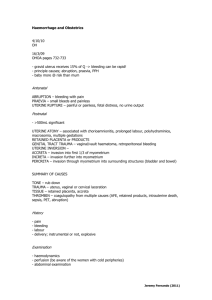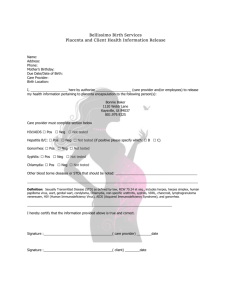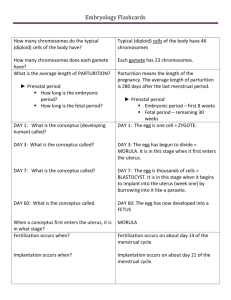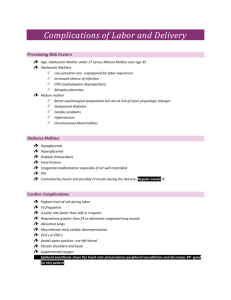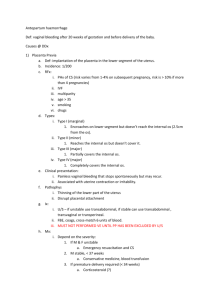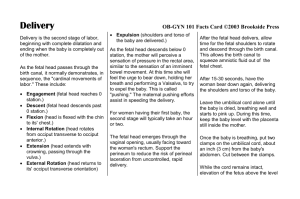A low-lying placenta after 20 weeks (placenta praevia): Information
advertisement
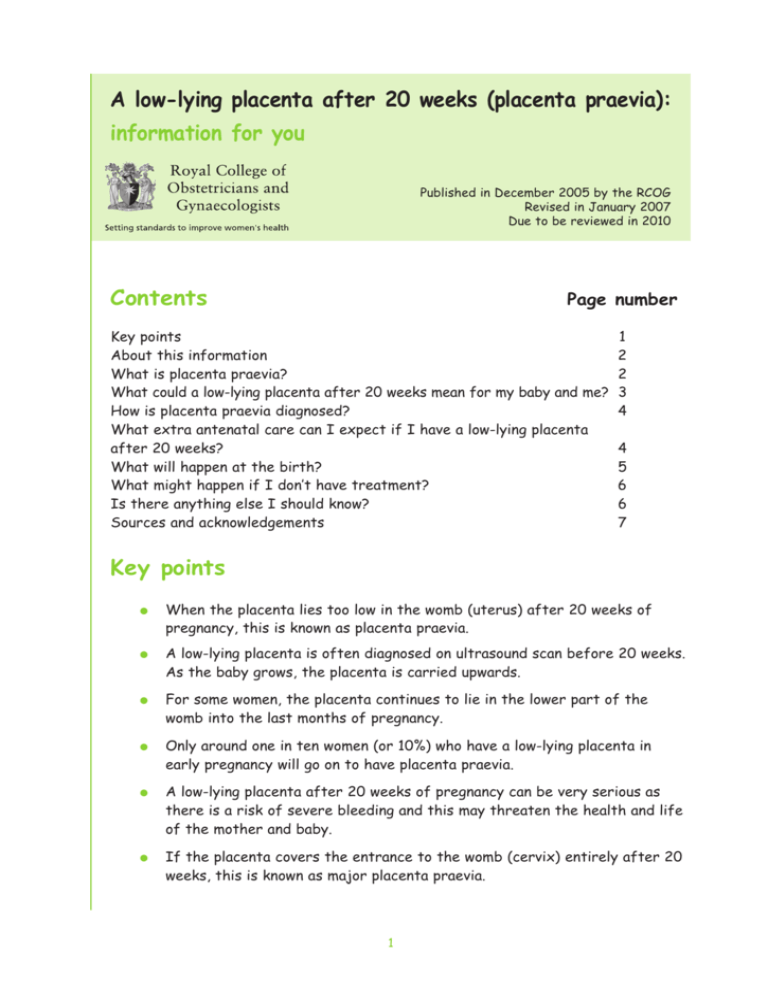
A low-lying placenta after 20 weeks (placenta praevia): information for you Published in December 2005 by the RCOG Revised in January 2007 Due to be reviewed in 2010 Contents Page number Key points About this information What is placenta praevia? What could a low-lying placenta after 20 weeks mean for my baby and me? How is placenta praevia diagnosed? What extra antenatal care can I expect if I have a low-lying placenta after 20 weeks? What will happen at the birth? What might happen if I don’t have treatment? Is there anything else I should know? Sources and acknowledgements 1 2 2 3 4 4 5 6 6 7 Key points ● When the placenta lies too low in the womb (uterus) after 20 weeks of pregnancy, this is known as placenta praevia. ● A low-lying placenta is often diagnosed on ultrasound scan before 20 weeks. As the baby grows, the placenta is carried upwards. ● For some women, the placenta continues to lie in the lower part of the womb into the last months of pregnancy. ● Only around one in ten women (or 10%) who have a low-lying placenta in early pregnancy will go on to have placenta praevia. ● A low-lying placenta after 20 weeks of pregnancy can be very serious as there is a risk of severe bleeding and this may threaten the health and life of the mother and baby. ● If the placenta covers the entrance to the womb (cervix) entirely after 20 weeks, this is known as major placenta praevia. 1 ● If you have major placenta praevia you will need a caesarean section. ● Maternal deaths from placenta praevia are fortunately very rare. Each year in the UK, there are 600,000 deliveries; about three women die as a result of placenta praevia. About this information This information is intended to help you if you have, or have been told you may have a low-lying placenta after 20 weeks (placenta praevia). It is based on the Royal College of Obstetricians and Gynaecologists (RCOG) guideline Placenta praevia and placenta praevia accreta: diagnosis and management (published by the RCOG in 2001 and revised in October 2005). It tells you about: ● a low-lying placenta after 20 weeks and why it happens ● how it is diagnosed ● what extra antenatal care you can expect if you have placenta praevia ● what your care will be at delivery. This information aims to help you and your healthcare team make the best decisions about your care. It is not meant to replace advice from a doctor or midwife about your own situation. This information tells you about the recommendations in the RCOG guideline. It does not try to explain the reasons for placenta praevia in detail. It does not tell you about other problems that may arise with the placenta in pregnancy. Some of the recommendations here may not apply to you. This could be because of some other illness you have, your general health, your wishes, or some or all of these things. If you think the treatment or care you get does not match what we describe here, discuss this with your doctor, midwife or another member of your healthcare team. What is placenta praevia? The placenta develops along with the baby in the womb during pregnancy. It links the baby with the mother’s blood system and provides the baby with its source of oxygen and nourishment. The placenta is delivered after the baby, and is also called the afterbirth. 2 In some women the placenta attaches too low in the womb and covers a part or all of the entrance to the womb (cervix). This attachment often shows up in early ultrasound scans, when it is sometimes called a low-lying placenta. In most cases, the placenta is carried upwards, as the womb stretches around the growing baby, and so it does not cause a problem. For some women, however, the placenta continues to lie in the lower part of the womb into the last months of pregnancy. This condition is known as placenta praevia. If the placenta covers the entrance to the womb (cervix) entirely, this is known as major placenta praevia. The placenta may lie in the lower part of the womb (placenta praevia) or it may cover the entrance to the womb entirely (major placenta praevia) Rarely, placenta praevia may be complicated by a problem known as placenta accreta. This is when the placenta is abnormally attached to the womb, making separation at the time of birth difficult. Placenta accreta is more commonly found in women with placenta praevia who have previously had a caesarean birth. What could a low-lying placenta after 20 weeks mean for my baby and me? If you have a low-lying placenta after 20 weeks you may experience vaginal bleeding during your pregnancy. Bleeding from placenta praevia can occasionally be very severe, and so put the life of the mother and baby in danger. The bleeding can be treated and deaths from placenta praevia are rare. If the placenta is low-lying in the womb after 20 weeks, it may prevent the baby from getting into the normal position of head first. Your baby may lie bottom first (known as the breech position) or lying across the womb (known as transverse) around the time of birth. 3 Women with placenta praevia usually need a caesarean section. Rarely, the bleeding is so much that you may need a blood transfusion. If the bleeding continues and cannot be controlled, a hysterectomy (removing the womb) may be the only means of controlling the bleeding. If there is a lot of bleeding before your due date, you may have to be delivered earlier than planned. The earlier the baby is born before the due date, the higher the risk of health problems. The risk is greatest if the baby is born very early, that is, before 31 completed weeks of pregnancy. Premature babies may have problems with normal activities, such as feeding and breathing, and they are at greater risk of having health problems such as infection and jaundice. Because of this, early delivery by caesarean section is only considered if the bleeding is severe enough to cause risk to you or your or baby (see section on What will happen at the birth?). How is placenta praevia diagnosed? A low-lying placenta is often suspected during a 20-week ultrasound scan. Most women who have a low-lying placenta in early pregnancy will not go on to have a low-lying placenta later on; about one in ten of these women (or 10%) will go on to have placenta praevia. Occasionally, placenta praevia may be picked up later in pregnancy, if the baby is found to be lying in an awkward position or if you have been bleeding. For most women a diagnosis of placenta praevia is made in the second half of pregnancy. The best way to confirm whether or not you have placenta praevia is with a transvaginal ultrasound scan. If your doctor thinks you may have placenta praevia (for instance, if you have vaginal bleeding) you may be offered additional ultrasound scans to investigate and monitor the pregnancy. What extra antenatal care can I expect if I have a low-lying placenta after 20 weeks? One extra scan may be all that is needed to monitor the position of the placenta. If your placenta is no longer low-lying, you will have normal antenatal care. If your placenta remains low-lying in the second half of pregnancy (after 20 weeks), you will have at least one more transvaginal ultrasound scan to check whether the position of the placenta has lifted with the development and stretching of the womb. Additional extra care will be given based on your individual circumstances. If you have major placenta praevia (the placenta covers the entrance to the womb (cervix)) or placenta accreta is suspected, you may be offered admission to hospital 4 after 34 weeks of pregnancy. Even if you have had no symptoms before, there is a small risk that you could bleed suddenly and severely, which may mean that you need an urgent caesarean section. If you have a low-lying placenta after 20 weeks and you have no bleeding, then you may be able to have care at home. However, you should be able to get to hospital quickly and easily at any time. You should call for an ambulance, should this need arise. After you have been told that you have placenta praevia, you and your partner should have the opportunity to discuss the options for delivery with your doctor. Depending on your circumstances, you may be advised to have a planned caesarean section. You will also need to consider what would happen in the case of an emergency. Your doctor and midwife should tell you more about this. In a few instances, a blood transfusion is essential to save your life and the life of your baby. If you feel that you could never accept a blood transfusion, then you should explain this to your obstetrician and midwife as early as possible. You can then discuss any objections or particular questions that you may have. What will happen at the birth? Your healthcare team will recommend the best way for you to give birth based on your own individual circumstances. If, on your scan at 32 to 36 weeks, your placenta is less than 2 centimetres from the entrance to the womb (cervix), you will almost certainly need a caesarean section. If this is the case, you should be delivered by the most experienced obstetrician and anaesthetist on duty. A consultant obstetrician and anaesthetist should be present within the delivery suite at this time. This is particularly important if you have previously had a caesarean section. If an emergency arises, a consultant will be present. Your anaesthetist will discuss the options for anaesthesia if you need a caesarean section. You may need to have a general anaesthetic. If you have a caesarean section because of placenta praevia, you are more likely to need a blood transfusion. Blood supplies should be available, as necessary, for your individual circumstances. Removal of the womb (a hysterectomy) is sometimes necessary if there is lifethreatening bleeding. 5 It may be hard to be sure whether there is placenta accreta before surgery, but if this is thought to be likely your doctor may explain it to you beforehand. The risks are particularly high if you have placenta praevia and have had a caesarean section before. Some women with placenta praevia and/or placenta accreta may lose such a lot of blood that it endangers their lives. When this happens, there are special hospital procedures to care for women with this condition. What might happen if I don’t have treatment? You may lose a lot of blood. A low-lying placenta after 20 weeks is a serious and lifethreatening condition. There is a risk of death for you and/or your baby. Is there anything else I should know? ● You may have been advised to avoid having sexual intercourse during pregnancy, particularly if you have been bleeding. ● You may be offered an examination with a speculum (a plastic or metal instrument used to separate the walls of the vagina) to see how much and where your bleeding is coming from. This is an entirely safe examination. ● If you have a low-lying placenta you should eat a healthy diet rich in iron to reduce the risk of anaemia. ● Unless there is severe bleeding or another indication, delivery by caesarean section should be performed after 38 weeks. ● You have the right to be fully informed about your health care and to share in making decisions about it. Your healthcare team should respect and take account of your wishes. ● You can find more information about what having an anaesthetic during labour involves at www.oaa-anaes.ac.uk [Obstetric Anaesthetists’ Association]. 6 Sources and acknowledgements This information is based on the Royal College of Obstetricians and Gynaecologists (RCOG) guideline Placenta praevia and placenta praevia accreta: diagnosis and management (published by the RCOG in 2001 and revised in October 2005). The guideline contains a full list of the sources of evidence we have used. You can find it online at www.rcog.org.uk. Clinical guidelines are intended to improve care for patients. They are drawn up by teams of medical professionals and consumers’ representatives, who look at the best research evidence there is about care for a particular condition or treatment. The guidelines make recommendations based on this evidence. This information has been developed by the Patient Information Subgroup of the RCOG Guidelines and Audit Committee, with input from the Consumers’ Forum and the authors of the clinical guideline. It was reviewed before we published it by women attending clinics in London. The final version is the responsibility of the Guidelines and Audit Committee of the RCOG. The RCOG consents to the reproduction of this document providing full acknowledgement is made. The text of this publication may accordingly be used for printing with the addition of local information or as the basis for audiotapes or for translations into other languages. Information relating to clinical recommendations must not be changed. © Royal College of Obstetricians and Gynaecologists 2005 7
